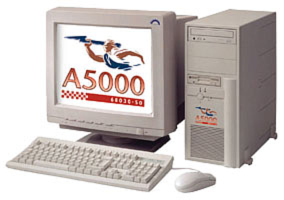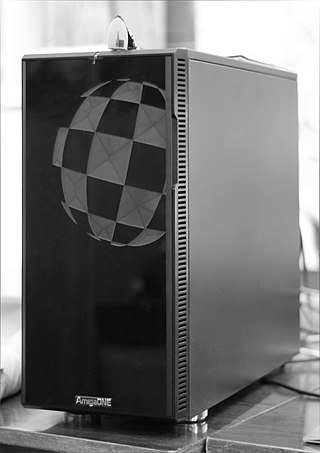APUS stands for "Amiga Power Up System", and describes a computer comprising an Amiga computer with a Phase5 PowerUP PowerPC accelerator board. [1]

Amiga is a family of personal computers introduced by Commodore in 1985. The original model is one of a number of mid-1980s computers with 16- or 16/32-bit processors, 256 KB or more of RAM, mouse-based GUIs, and significantly improved graphics and audio compared to previous 8-bit systems. These systems include the Atari ST—released earlier the same year—as well as the Macintosh and Acorn Archimedes. Based on the Motorola 68000 microprocessor, the Amiga differs from its contemporaries through the inclusion of custom hardware to accelerate graphics and sound, including sprites and a blitter, and a pre-emptive multitasking operating system called AmigaOS.

PowerPC is a reduced instruction set computer (RISC) instruction set architecture (ISA) created by the 1991 Apple–IBM–Motorola alliance, known as AIM. PowerPC, as an evolving instruction set, has been named Power ISA since 2006, while the old name lives on as a trademark for some implementations of Power Architecture–based processors.
AmigaOne is a series of computers intended to run AmigaOS 4 developed by Hyperion Entertainment, as a successor to the Amiga series by Commodore International. Earlier models were produced by Eyetech, and were based on the Teron series of PowerPC POP mainboards. In September 2009, Hyperion Entertainment secured an exclusive licence for the AmigaOne name and subsequently new AmigaOne computers were released by A-Eon Technology and Acube Systems.
MorphOS is an AmigaOS-like computer operating system (OS). It is a mixed proprietary and open source OS produced for the Pegasos PowerPC (PPC) processor based computer, PowerUP accelerator equipped Amiga computers, and a series of Freescale development boards that use the Genesi firmware, including the Efika and mobileGT. Since MorphOS 2.4, Apple's Mac mini G4 is supported as well, and with the release of MorphOS 2.5 and MorphOS 2.6 the eMac and Power Mac G4 models are respectively supported. The release of MorphOS 3.2 added limited support for Power Mac G5. The core, based on the Quark microkernel, is proprietary, although several libraries and other parts are open source, such as the Ambient desktop.

Christopher Hülsbeck, known internationally as Chris Huelsbeck, is a German video game music composer. He gained popularity for his work on game soundtracks for The Great Giana Sisters and the Turrican series.
PowerPC G4 is a designation formerly used by Apple and Eyetech to describe a fourth generation of 32-bit PowerPC microprocessors. Apple has applied this name to various processor models from Freescale, a former part of Motorola. Motorola and Freescale's proper name of this family of processors is PowerPC 74xx.

A power-on self-test (POST) is a process performed by firmware or software routines immediately after a computer or other digital electronic device is powered on.

Phase5 Digital Products is a defunct German computer hardware manufacturer that developed third-party hardware primarily for the Amiga platform. Their most popular products included CPU upgrade boards, SCSI controllers and graphics cards.
This is a list of models and clones of Amiga computers.
The Amiga is a family of home computers that were designed and sold by the Amiga Corporation from 1985 to 1994.
The Amiga computer can be used to emulate several other computer platforms, including legacy platforms such as the Commodore 64, and its contemporary rivals such as the IBM PC and the Macintosh.
AmigaOS is the proprietary native operating system of the Amiga personal computer. Since its introduction with the launch of the Amiga 1000 in 1985, there have been four major versions and several minor revisions of the operating system.

Bomberman is an action-maze video game originally developed and published by Hudson Soft for the PC Engine in Japan on 7 December 1990 and later in North America for the TurboGrafx-16 by NEC in 1991. Belonging to the Bomberman franchise, it is a re-imagining of the first game in the series starring White Bomberman on a quest to rescue Lisa, the kidnapped daughter of his inventor Dr. Mitsumori, from the castle of Black Bomberman while defeating evil monsters and villains that work for him. The game was later ported to home computers, each one featuring changes compared to the original version. Conversions for other platforms were in development but never released. The title garnered positive reception from critics since its initial release on the PC Engine/TurboGrafx-16 and later on home computers.
WarpOS is a multitasking kernel for the PowerPC (PPC) architecture central processing unit (CPU) developed by Haage & Partner for the Amiga computer platform in the late 1990s and early 2000s. It runs on PowerUP accelerator boards developed by phase5 which contains both a Motorola 68000 series CPU and a PowerPC CPU with shared address space. WarpOS runs alongside the 68k-based AmigaOS, which can use the PowerPC as a coprocessor. Despite its name, it is not an operating system (OS), but a kernel; it supplies a limited set of functions similar to those in AmigaOS for using the PowerPC. When released, its original name was WarpUP, but was changed to reflect its greater feature set, and possibly to avoid comparison with its competitor, PowerUP.

The Amiga 1200, or A1200, is a personal computer in the Amiga computer family released by Commodore International, aimed at the home computer market. It was launched on October 21, 1992, at a base price of £399 in the United Kingdom and $599 in the United States.

The Power A5000 was a planned Amiga clone computer, announced by German DCE Computer Service GmbH and British Amiga peripherals manufacturer Power Computing Ltd.. It was one of the first Amiga clone computers announced after Gateway purchased the Amiga in 1997.

AmigaOne X1000 is a PowerPC-based personal computer intended as a high-end platform for AmigaOS 4. It was announced by A-Eon Technology CVBA in partnership with Hyperion Entertainment and released in 2011. Its name pays homage to the Amiga 1000 released by Commodore in 1985. It is, however, not hardware-compatible with the original Commodore Amiga system.

Sam460ex is a line of modular motherboards produced by the Italian company ACube Systems Srl. The machine was released in October 2010 and can run AmigaOS 4, MorphOS, or Debian GNU/Linux.

PowerUP boards were dual-processor accelerator boards designed by Phase5 Digital Products for Amiga computers. They had two different processors, a Motorola 68000 series (68k) and a PowerPC, working in parallel, sharing the complete address space of the Amiga computer system.

Links: The Challenge of Golf is a golf video game developed by Access Software. It was published for MS-DOS in 1990, followed by the Amiga in 1992. A Sega CD version, developed by Papyrus Design Group, was released in 1994. It is the first game in the Links series, and was followed by Links 386 Pro (1992). A Microsoft Windows version, titled Microsoft Golf, was released in 1992 as the first game in the Microsoft Golf series.